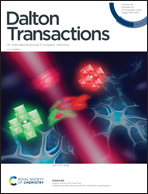The morphology evolution, tunable down-conversion luminescence, and energy transfer of [CaY]F2 crystals doped with Li+/Ce3+/Tb3+†
Abstract
Octahedral [CaY]F2 crystals with an average particle size of 1 μm were synthesized via a mild one-step hydrothermal route without employing any surfactants. Various morphologies, including cubes, truncated cubes, truncated octahedrons, and spheres, were achieved via manipulating the amount of EDTA used, and a possible growth mechanism was proposed based on the surface energies of different crystal planes and the influence of the surfactant. XRD, SEM, EDS, TEM, HRTEM, and PL analysis were used to characterize the products. The effects of the morphologies and Li+ doping concentrations on the luminescence intensities of the [CaY]F2:Ce3+/Tb3+ phosphors were explored, and the strongest luminescence intensity is obtained when the sample is cubic with (100) crystal faces and the doping concentration of Li+ is 0.25 mol%. Additionally, multicolor emission (blue → aquamarine blue → green) was obtained from [CaY]F2:Ce3+/Tb3+ phosphors via adjusting the doping concentration of Tb3+, which resulted from the Ce3+ → Tb3+ energy transfer behavior; the energy transfer here happened through a dipole–dipole mechanism. This work may result in the as-synthesized phosphors having great application potential in many optoelectronic device fields, such as in displays and multicolor lighting.
![Graphical abstract: The morphology evolution, tunable down-conversion luminescence, and energy transfer of [CaY]F2 crystals doped with Li+/Ce3+/Tb3+](/en/Image/Get?imageInfo.ImageType=GA&imageInfo.ImageIdentifier.ManuscriptID=D0DT02955F&imageInfo.ImageIdentifier.Year=2020)


 Please wait while we load your content...
Please wait while we load your content...